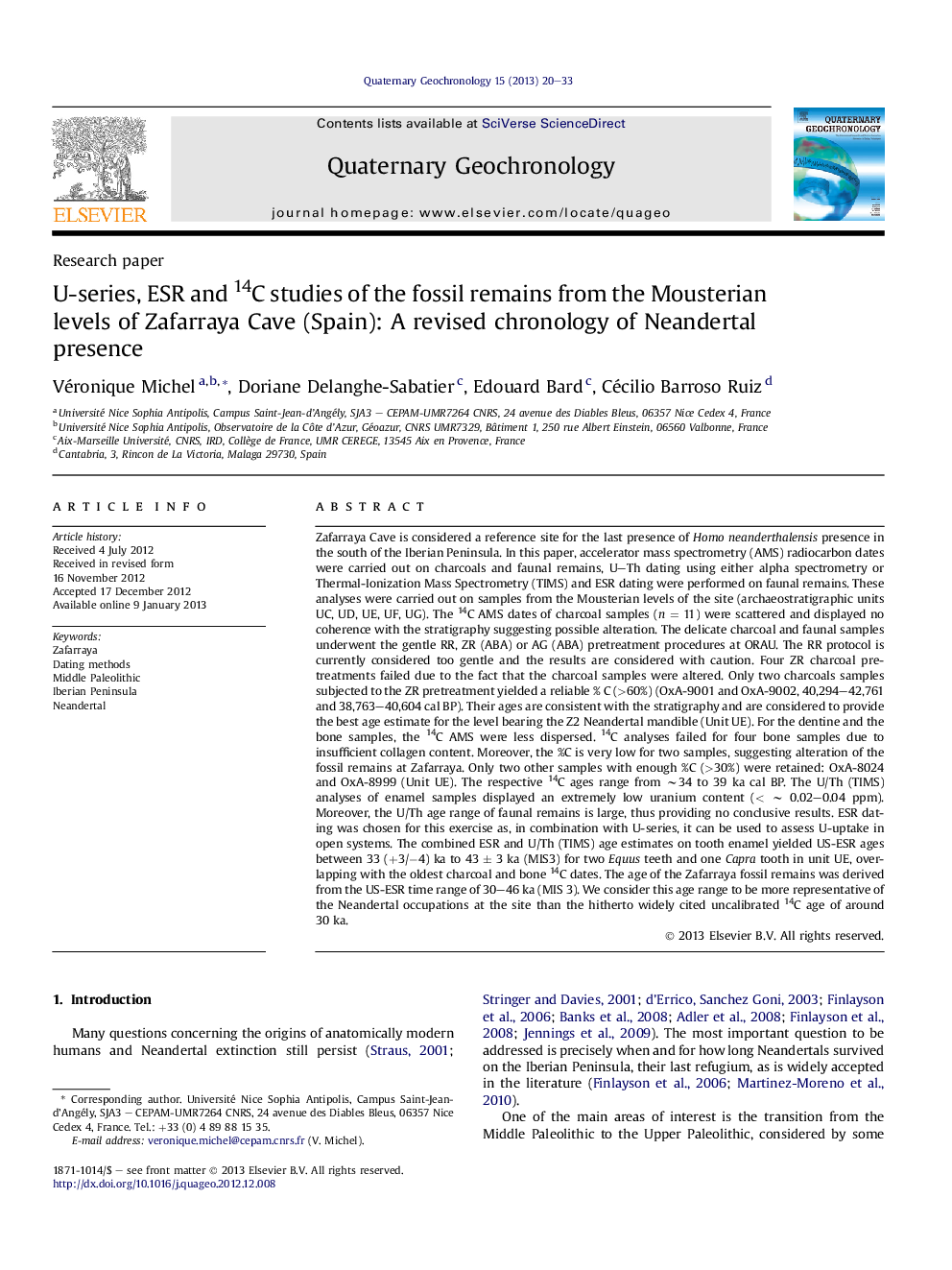| کد مقاله | کد نشریه | سال انتشار | مقاله انگلیسی | نسخه تمام متن |
|---|---|---|---|---|
| 4725066 | 1639861 | 2013 | 14 صفحه PDF | دانلود رایگان |

Zafarraya Cave is considered a reference site for the last presence of Homo neanderthalensis presence in the south of the Iberian Peninsula. In this paper, accelerator mass spectrometry (AMS) radiocarbon dates were carried out on charcoals and faunal remains, U–Th dating using either alpha spectrometry or Thermal-Ionization Mass Spectrometry (TIMS) and ESR dating were performed on faunal remains. These analyses were carried out on samples from the Mousterian levels of the site (archaeostratigraphic units UC, UD, UE, UF, UG). The 14C AMS dates of charcoal samples (n = 11) were scattered and displayed no coherence with the stratigraphy suggesting possible alteration. The delicate charcoal and faunal samples underwent the gentle RR, ZR (ABA) or AG (ABA) pretreatment procedures at ORAU. The RR protocol is currently considered too gentle and the results are considered with caution. Four ZR charcoal pretreatments failed due to the fact that the charcoal samples were altered. Only two charcoals samples subjected to the ZR pretreatment yielded a reliable % C (>60%) (OxA-9001 and OxA-9002, 40,294–42,761 and 38,763–40,604 cal BP). Their ages are consistent with the stratigraphy and are considered to provide the best age estimate for the level bearing the Z2 Neandertal mandible (Unit UE). For the dentine and the bone samples, the 14C AMS were less dispersed. 14C analyses failed for four bone samples due to insufficient collagen content. Moreover, the %C is very low for two samples, suggesting alteration of the fossil remains at Zafarraya. Only two other samples with enough %C (>30%) were retained: OxA-8024 and OxA-8999 (Unit UE). The respective 14C ages range from ∼34 to 39 ka cal BP. The U/Th (TIMS) analyses of enamel samples displayed an extremely low uranium content (< ∼ 0.02–0.04 ppm). Moreover, the U/Th age range of faunal remains is large, thus providing no conclusive results. ESR dating was chosen for this exercise as, in combination with U-series, it can be used to assess U-uptake in open systems. The combined ESR and U/Th (TIMS) age estimates on tooth enamel yielded US-ESR ages between 33 (+3/−4) ka to 43 ± 3 ka (MIS3) for two Equus teeth and one Capra tooth in unit UE, overlapping with the oldest charcoal and bone 14C dates. The age of the Zafarraya fossil remains was derived from the US-ESR time range of 30–46 ka (MIS 3). We consider this age range to be more representative of the Neandertal occupations at the site than the hitherto widely cited uncalibrated 14C age of around 30 ka.
► 14C, U/Th and ESR dating results of the Neandertal remains levels (Unit UE) are presented in detail.
► Faunal 14C calibrated dates yielded a time range of 34–39 ka; U/Th data are scattered.
► The oldest 14C dates of 39–43 ka cal BP were obtained on charcoal samples (MIS3).
► The US-ESR method yielded age estimates range between 33 (+3/−4) ka to 43 ± 3 ka.
► Neandertal occupations are within the time range of 30–46 ka.
Journal: Quaternary Geochronology - Volume 15, February 2013, Pages 20–33